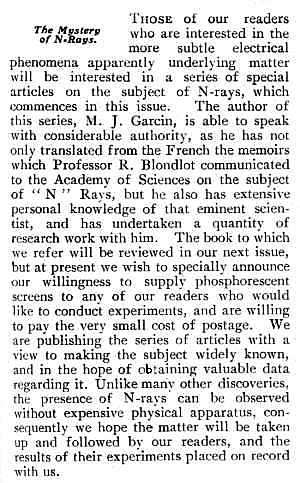Updated: 22 Oct 2006




The N-ray Imbroglio. |
Updated: 22 Oct 2006
 
|
In 1903, Rene Blondlot, a respected French physicist, claimed to have discovered a new form of radiation he called "N- rays". This was shortly after the discovery of X-rays by Roentgen, so rays were in the air, as it were, and so was a desire to keep up with the Germans. The N-radiation was apparently mysteriously refracted by aluminium prisms; but the crucial factor was that its presence could only be shown by subjective assessment of the brightness of an electric arc allegedly affected by N-rays. No objective measurement appeared to be possible. To Blondlot, and at least fourteen of his professional colleagues, the subtle changes in brightness were real, and the French Academy published more than a hundred papers on the subject.
Unfortunately N-rays were completely imaginary, a classic product of the "experimenter-expectancy" effect. This was demonstrated by American scientist Robert Wood, who quietly pocketed the aluminium prism during a demonstration, without affecting Bondlot's recital of the results. This was widely reported by the famous reporter/explorer William Seabrook, and the N-ray industry collapsed very quickly. It was a major embarrassment at the time, but is now almost forgotten.
This demonstrates with brutal clarity that it is quite possible for large numbers of sincere people to deceive themselves when trying to perform subjective assessments of phenomena.
On this page I have reproduced some very rare articles written while the affair was still in its early stages.
 | 
| Left: from The Electrical Magazine, first half of 1904, p514.
|
 | Left: from The Electrical Magazine, first half of 1905, p413.
|

  
|